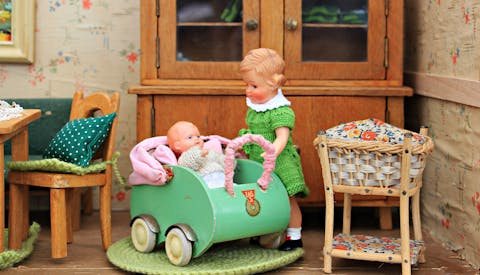Learn About Toys
Toys are objects that possess an inherent sense of joy and imagination, as they play a significant role in our early development and childhood no matter what background one comes from.
three antique teddy bears
While manufactured toys are only a relatively recent phenomenon, children have played with toys in some form or another since the beginnings of humanity. As we associate these objects with the play of simpler times and the happiness which it brought to us, it is easy to see why there is an increasing market for vintage and antique toys; many collectors are keen on the idea of being able to hold onto the pleasant nostalgia of youth, perhaps add to a collection of a favorite toy brand, or simply admire a fun piece of history.
Ancient Toys
When one thinks of toys, the images that come to mind are often the stuffed animals, plastic dolls, and mechanical figures that were in our own toy chests growing up. In fact, children have been playing with toys since before recorded history. Because of this, the exact nature or location of the origin of toys is unknown, but dolls and figures that are representative of animals, infants, and soldiers are found frequently at archaeological excavations, with the oldest known toy is a doll estimated to be over 4,000 years old. These early examples were often made from readily available materials such as wood, clay, rocks, and sticks.
Ancient Egyptian tombs of children housed sophisticated play objects such as wooden carved animals on wheels with mouths that opened and closed and dolls with wigs and moveable limbs. In Europe, children played with carts, balls, and rackets. Ancient Greek and Roman children played with yo-yos, bows and arrows, and wax or terracotta dolls. It was often customary for Greek girls to offer their toys to the Gods at temples on the eve of their weddings as a rite of passage into adulthood.
"By the Enlightenment era, attitudes towards children themselves were shifting; they began to be seen as people of their own with the rights to a childhood instead of mere extensions of their parents and tools of the household."
Early Modern Toys
By the 16th century, the nature of toys had changed little throughout the centuries. Popular toys included a cup and ball in which a ball was attached to a string connecting a handle with a cup on on one end which one would swing and try to catch the ball in. Also a favorite were wooden dolls known as Bartholomew dolls which earnt their name because they were sold at London’s St. Bartholomew fair. In 1558, the first ever doll house was created in Germany.
By the Enlightenment era, attitudes towards children themselves were shifting; they began to be seen as people of their own with the rights to a childhood instead of mere extensions of their parents and tools of the household. Because of this, the variety of toys began to increase during the 18th century. Jigsaw puzzles were created in order to help children learn their geography, rocking horses were made to help develop a child’s balance for riding real horses, and many new board games were developed in order to stimulate the imagination, such as A Journey Through Europe.

19th Century Toys
By the advent of the Industrial Revolution, the middle class was beginning to grow and prosper and more children had increasing leisure time on their hands. In addition to the boom of new technologies subsequent of the Industrial Revolution, these methods could be use in order to meet the growing demand for play items. Toys involving more advanced mechanisms and optics were invented such as animatronic dolls and figures, jack-in-the-box, kaleidoscopes, magic lanterns, and zoetropes. Girls played with dolls made of wood, wax, porcelain, and kid leather, and boys enjoyed marbles and model trains.
By the turn of the century, toy manufacturing was reaching its golden age. Middle class wages were rising and technology had improved significantly so that sophisticated and complex toys and mechanisms were available to many. It was emphasized that toys ought to be intellectually stimulating for the benefit of the child’s development. New materials were being invented that enabled all sorts of new play things on the market.
Modern Toys
During the 20th century, the toy industry quickly became a massive market, churning out many of the products we are still familiar with today. Play-doh, Barbie, Mr. Potato Head, Silly Putty, Legos, Action Man, Rubik’s Cube, Slinky, and much more were all created before the 1960’s. Multi billion dollar mass manufacturing toy moguls rose up such as Hasbro, Mattel, and Fisher-Price. Today many toys display how current technology is changing play time from tangible to digital as the world changes in the wake of revolutionary new technologies. Never the less, toys continue to play an essential role in our early development as people, not to mention providing endless hours of sheer delight and entertainment. It is no wonder that so many people today are intrigued by the distant and yet familiar sense of sentimental pleasure that one feels in the presence of an old toy.

